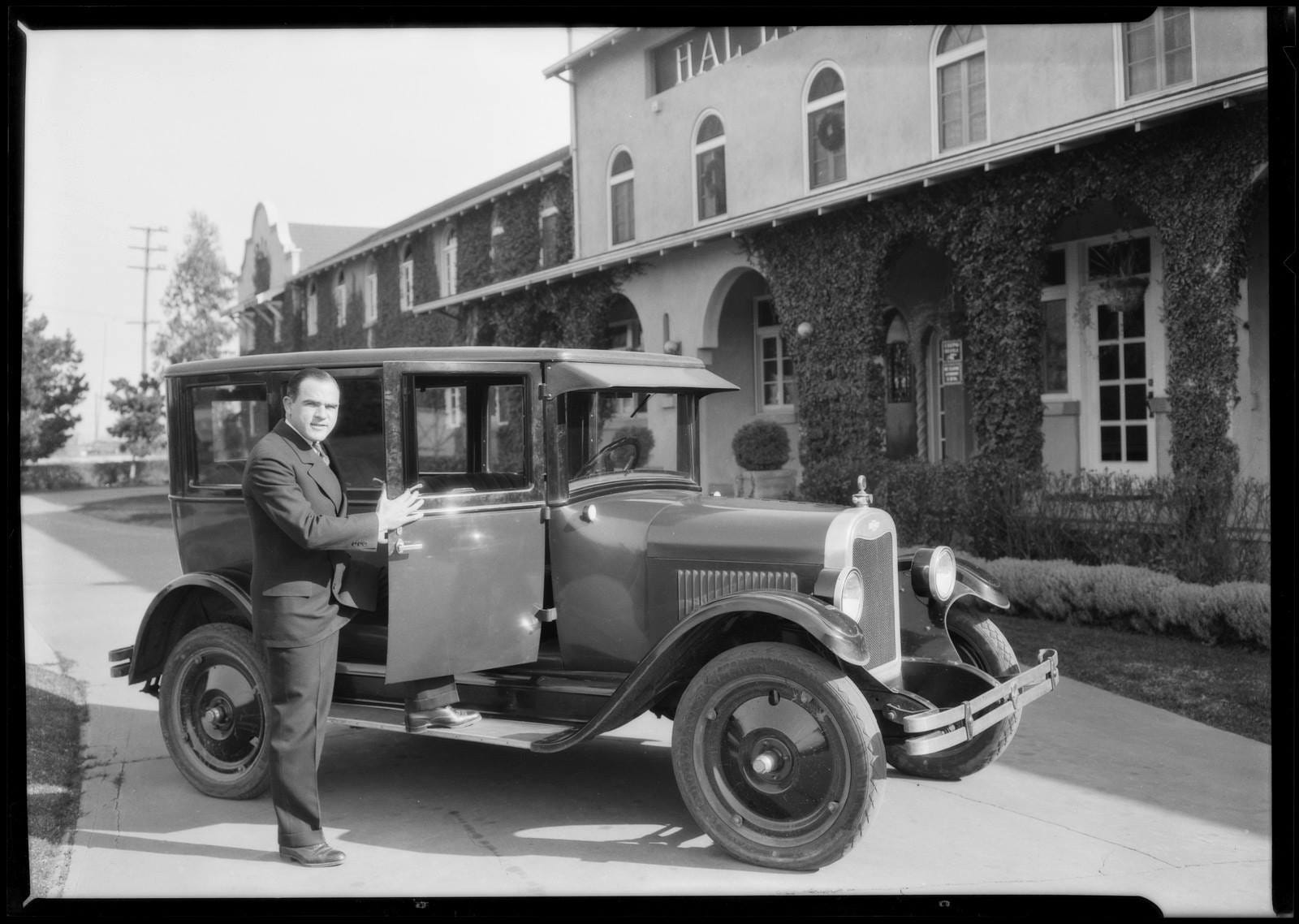Hal Roach Studios’ 20th Anniversary Party

Hal Roach is arguably the most deserving individual to reside at the summit of comedy’s Mt. Olympus for his contributions to the art form a century ago.
He had been working as an actor, stagehand, and whatever film-related position he could find for himself when, in 1914, he was able to establish his own production company with money from a family inheritance. He still had a limited budget to work with, however, requiring him to rely greatly on various locations around Los Angeles, but his dedication to comedy was to attract the best in the business, both in front of and behind the camera.
The first comedy star he created was Harold Lloyd, who, during his years with Roach Studios, was to become one of the most revered and highest grossing film stars of the 1920s.

Roach created Our Gang comedy series in 1922, with the first short titled, appropriately enough, Our Gang. This one-reeler would be the first of over 200 short subjects comedies starring the gang (later known as “The Little Rascals” for TV syndication). He said he first got the idea of a film featuring kids after finding himself mesmerized watching a group of kids playing in a vacant lot one day. He felt there was ample comic potential in the idea, and created Our Gang.

In 1927, he brought Stan Laurel and Oliver Hardy together. Both comedians had been working separately for Roach, and occasionally appeared in the same films, but not together. Over time, as Stan and Ollie began sharing more scenes, they developed an on-screen chemistry, especially evident in their first true effort together, Duck Soup (no relation to the later Marx Brothers feature). Roach and director Leo McCarey were astute enough to notice, pursue, and develop the smooth rapport between Stan and Ollie. The first film billed as a “Laurel & Hardy” film was 1927’s Putting Pants on Phillip, although they had not yet blossomed into their now-familiar screen characters. While it’s a matter of continuing debate which Laurel & Hardy film was their first as a true team, by the end of 1927 they were acknowledged and billed as such.

By 1929, Hal Roach Studios was even outshining rival Mack Sennett as the top comedy film studio in the business, with the best of its creative output still to come. By the time Laurel & Hardy’s first sound film, Unaccustomed as We Are, was produced, they had developed their familiar characters and attire, creating the symbiotic working relationship that would come to be envied by other comedy teams of the time, and of those teams to follow.
Although the two were the first major silent film comedians to take the plunge into sound successfully, they felt little need to be intimidated by the new facet of their work. They planned to use dialogue sparingly anyway, without forcing it on either themselves or their audience, even though Fate had given them the voices that perfectly matched their characters’ mannerisms and body language: Ollie was ever the dignified, if sometimes pompous, dominant half, who spoke with a slight, gentlemanly Southern accent, while Stan was childlike, accident-prone, and, more often than not, willing to follow Ollie’s lead.
There have been countless volumes written about their years as a team, but to put it simply, Stan and Ollie were the perfect film comedy team, the best that ever was.
Elsewhere at Roach Studios, beginning in 1929 Roach put aspiring comic actress Thelma Todd in a number of shorts starring his biggest solo personality, Charley Chase. Director Leo McCarey recalled, “I had so many ideas for gags that [Roach] gave me an actor named Charley Chase and he let me direct him. I was fortunate enough to draw a very clever fellow. He was a big help to me and I hope that I reciprocated to him. And our pictures were extremely successful.”

Chase and Todd were essentially a team in all but official billing, and demonstrated terrific comedy chemistry. Many of the film plots were variations of Charley’s attempts to win her over, with complications or misunderstandings getting in the way. Among the best of these are Looser than Loose, and especially The Pip from Pittsburgh. In the latter, Charley tries to get out of a blind date, until he discovers it’s the gorgeous Thelma. Photoplay said, “Two tried and true troupers, Charley Chase and Thelma Todd, manage to get a good deal of fun out of a slim script.”
Just when it looked as if the two would soon be officially billed as equal co-stars, Roach decided he wanted to pair Thelma with another female, ZaSu Pitts, to create a female team as a counterpart to Laurel & Hardy, with Thelma as the energetic go-getter, and ZaSu as her put-upon, accident- prone pal with a sullen face.
Roach had previously experimented with a female comedy duo when he paired Anita Garvin with Marion Byron (Garvin was nearly six feet tall, provided an amusing physical contrast to the petite Byron), and the two showed promise as a team, especially in the Roach silent short A Pair of Tights, a true silent comedy classic if there ever was one. Their teaming, unfortunately, lasted only for three shorts.
ZaSu Pitts (pronounced “Zay-Su,” a combination of her aunts’ names, Eliza and Susan) had made a name for herself primarily as a dramatic silent film actress, but it was her forays into comedy that began winning audiences over.
Roach was so enthusiastic about the new team that he directed Let’s Do Things himself, as he did for other top-notch entries in their series, Pajama Party and On the Loose, until his duties as studio chief prompted him to leave the directing to others. Variety noted that Pajama Party is an “old fashioned two-reeler idea, but with the sex angle reversed. Two women do the comedy and take the falls…a first rate team with all the requirements. [They] could continue indefinitely as a combination for two reelers. They make the old gags sound slightly different.”
The team would make 17 two-reelers together (like Laurel & Hardy and most of Roach’s all-stars, the two used their real names in their films, a charming custom which no doubt created a greater personal connection with audiences). Many of the scenarios involve ZaSu getting pulled into Thelma’s plans without time to object.

The series as a whole also benefitted from ever-reliable Roach supporting players such as Billy Gilbert, Charlie Hall, and the aforementioned Garvin (whose hilarious performance in the short Show Business very nearly steals the film right out from under Thelma and ZaSu).
ZaSu left Roach studios in mid-1933, when negotiations to renew her contract broke down. She went elsewhere to pursue both comic and dramatic roles, but regretted leaving her close friend Thelma. Roach replaced ZaSu with Patsy Kelly, a Brooklyn native who provided a brash, wisecracking New York character to the series.

Patsy later confessed to being somewhat unprepared for all of the slapstick she would be expected to perform on camera. However, as a sharp contrast to ZaSu’s meek, awkward screen character, Patsy proved to be another good fit for Thelma. The two would continue the series with twenty-one shorts together.
By the end of 1933, the Roach studio was at a creative peak, cranking out high-quality comedies at an impressive rate by the most comedy-savvy minds in the business, even as the Depression put a considerable dent in its profits (and those for other film studios at the time). Laurel & Hardy’s classic The Music Box had even won an Academy Award.
On December 7, Roach threw a 20th anniversary party for his stars and behind-the-scenes employees.

Part of the celebration was broadcast live on radio, and those who stepped before the microphone included Charley Chase, Will Rogers, MGM chief Louis B. Mayer, Jean Harlow, Thelma Todd and Patsy Kelly, and Laurel & Hardy.
Despite such a line-up in attendance to pay tribute to their boss, Variety was less than impressed by their radio presence: “Hollywood ought to do better than this when going on the air. And a studio identified with comedies should be a lot funnier in its air presentation. Roach himself was in good taste and simple dignity when responding.”
There’s just no pleasing some people.

Below is an independently produced clip about the event (with, unfortunately, poorly read voiceover narration, partially drowned-out by the music).
As 1933 gave way to 1934, the studio continued producing its hilarious comedies, and would continue to do so through the rest of the decade. And, as the time-worn cliché goes, they are still enjoyed by millions today, although mostly viewed on devices never dreamed of in the 1930s.

Until next time…
If you enjoyed this article, please click the “follow” button and follow me on Medium (no charge) for more of my articles on popular culture, music, films, television, entertainment history, and just plain old history.
You can also become a member in the Medium Partner Program for a modest fee to help support my writing! https://garryberman.medium.com/membership
Read my previous articles about comedy history at the links below, and at the links below:
“Celebrating 100 Years of The Little Rascals” | by Garry Berman | Medium
“Happy 90th Birthday, ‘Duck Soup’! | by Garry Berman | Medium
“Comedy 101: Reliable Gags Used by the Legends” | by Garry Berman | Medium
“Pie in Your Eye: A History of the Pie-in-the-face Gag” https://garryberman.medium.com/pie-in-your-eye-a-history-of-the-pie-in-the-face-gag-4dd8c31286a0
“The Funniest Decade”| by Garry Berman | Medium
“Breaking the Fourth Wall (in comedy)” https://garryberman.medium.com/breaking-the-fourth-wall-in-comedy-51edfa9f88f0
“Whatever Happened to Comedy Teams?” https://garryberman.medium.com/whatever-happened-to-comedy-teams-7e243b5c9d45
“Halloween with Abbott & Costello” https://garryberman.medium.com/halloween-with-abbott-costello-2d39a21bbbba
“Buck Privates: An Appreciation” https://garryberman.medium.com/buck-privates-an-appreciation-da7b7d645fab
“Stars For a Cause: The Navy Relief Show of 1942” https://garryberman.medium.com/stars-for-a-cause-the-navy-relief-show-of-march-1942-af2ff6edf8d9
“Mary Kay and Johnny: Television’s First Sitcom” https://garryberman.medium.com/mary-kay-and-johnny-televisions-first-sitcom-835fec303b5e
“The First Person to be Censored on TV was…Eddie Cantor? https://garryberman.medium.com/eddie-cantor-the-first-person-to-be-censored-on-tv-78b56c68cae1
“A Tribute to Our Funniest Sitcom Moms” https://garryberman.medium.com/a-tribute-to-our-funniest-sitcom-moms-ed3f5757fe73
“Television’s Greatest Sitcom Dad?” https://garryberman.medium.com/televisions-greatest-sitcom-dad-ef2dab761525
“Television Stars Who Went From Hits to Flops” | by Garry Berman | Medium
“More TV Stars Who Went From Hits to Flops” | by Garry Berman | Medium
“Retro Review: ‘Local Hero” at 40’ | by Garry Berman | Medium
Please visit www.GarryBerman.com to read synopses and reviews of my books (including The Funniest Decade) and order them via the links to Amazon.com.
